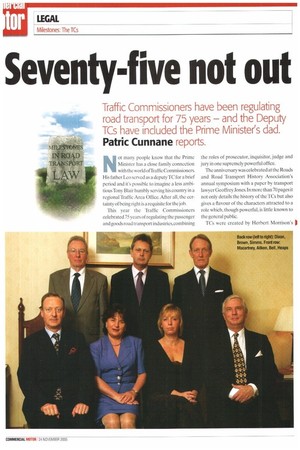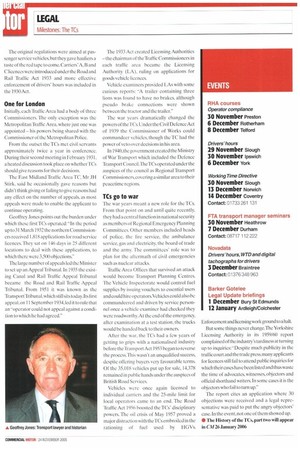Seventy-five not out
Page 44

Page 46

Page 48

If you've noticed an error in this article please click here to report it so we can fix it.
Traffic Commissioners have been regulating road transport for 75 years — and the Deputy TCs have included the Prime Minister's dad.
Patric Cunnane reports.
Nat many people know that the Prime Minister has a close family connection with the world ofTraffic Commissioners. His father Leo served as a deputy TC for a brief period and its possible to imagine a less ambitious Tony Blair humbly serving his country in a regional Traffic Area Office. After all, the certainty of being right is a requisite for the job.
This year the Traffic Commissioners celebrated 75 years of regulating the passenger and goods road transport industries.combining the roles of prosecutor, inquisitor, judge and jury in one supremely powerful office.
The anniversary was celebrated at the Roads and Road Transport History Association's annual symposium with a paper by transport lawyer Geoffrey Jones. In more than 70 pages it not only details the history of the TCs but also gives a flavour of the characters attracted to a role which, though powerful, is little known to the general public.
TCs were created by Herbert Morrison's I Road Traffic Act of 1930, which divided the country into 13TrafficAreas: 11 in England and Wales and two in Scotland. Each Traffic Area was presided over by a Traffic Area Commis sioner,later, known simply as aTraffic Commissioner. The first TCs were appointed on 1 January 1931 and had a statutory duty to report annually to the Minister of Transport.
Morrison was adamant that TCs shouldn't he under his direct control.
He told the Transport Select Committee that "in their handling of applications for licences they shall he perfectly free and independent to grant or refuse licences and to attach conditions and do all their duties on their own responsibility, using their judgement fairly. I want them to feel they are really free, independent men, acting judicially according to the evidence of each case put before them." The original regulations were aimed at passenger service vehicles, but they gave hauliers a taste of the red tape to come. Carriers' A,B and C licences were introduced under the Road and Rail Traffic Act 1933 and more effective enforcement of drivers' hours was included in the 1930 Act.
One for London
Initially, each Traffic Area had a body of three Commissioners. The only exception was the Metropolitan Traffic Area, where just one was appointed his powers being shared with the Commissioner of the Metropolitan Police.
From the outset the TCs met civil servants approximately twice a year in conference. During their second meeting in February 1931. a heated discussion took place on whether TCs should give reasons for their decisions.
The East Midland Traffic Area TC.:, Mr IN Stirk. said he occasionally gave reasons but didn't think giving or failing to give reasons had any effect on the number of appeals. as most appeals were made to enable the applicant to continue operating.
Geoffrey Jones points out the burden under which these first TCs operated: In the period up to 31 March 1932 the northern Commissioners received 1,818 applications for road service licences. They sat on 146 days in 25 different locations to deal with these applications, to which there were 3,500 objections."
The large number of appeals led the Minister to set up an Appeal Tribunal. In 1935 the existing Canal and Rail Traffic Appeal Tribunal became the Road and Rail Traffic Appeal Tribunal. From 1951 it was known as the Transport Tri bunal, which still sits today. Its first appeal,on 11 September 1934, led it to rule that an "operator could not appeal against a condition to which he had agreed." The 1933 Act created Licensing Authorities the chairman of the Traffic Commissioners in each traffic area became the Licensing Authority (LA), ruling on applications for goods vehicle licences.
Vehicle examiners provided LAs with sonic curious reports: "A trailer containing three lions was found to have no brakes, although pseudo brake connections were shown between the tractor and the trailer.
The war years dramatically changed the powers of the TCs. Under the Civil Defence Act of 1939 the Commissioner of Works could commandeer vehicles, though the Tc: had the power of veto over decisions in his area.
In 1940,the government created the Ministry of War Transport which included the Defence Transport Council.TheTCs operated under the auspices of the council as Regional Transport Commissioners, covering a similar area to their peacetime regions.
TCs go to war The war years Meant a new role for the ICs. From that point on and until quite recently, they had a central function in national security as members of Regional Emergency Planning Committees. Other members included heads of police, the fire service, the ambulance service, gas and electricity, the board of trade and the army. The committees' role was to plan for the aftermath of civil emergencies such as nuclear attacks.
Traffic Area Offices that survived an attack would become Transport Planning Centres. The Vehicle Inspectorate would control fuel supplies by issuing vouchers to essential users and could hire operators. Vehicles could also be commandeered and driven by service personnel once a vehicle examiner had checked they were roadworthy.At the end of the emergency, after examination at a test station, the trucks would be handed back to their owners.
After the war, the TCs had a few years of getting to grips with a nationalised industry before theTransport Act 1953 began to reverse the process. This wasn't an unqualified success, despite offering buyers very favourable terms. Of the 35,018 vehicles put up for sale, 14,378 remained in public hands under the auspices of British Road Services, Vehicles were once again licensed to individual carriers and the 25-mile limit for local operators came to an end. The Road Traffic Act 1956 boosted the TCs' disciplinary powers. The oil crisis of May 1957 proved a major distraction with the TCs embroiled in the rationing of fuel used by FIGVs. Enforcement and licensing work ground to a halt.
But some things never change. The Yorkshire Licensing Authority in its 1959/60 report complained of the industry's tardiness at turning up to inquiries: "Despite much publicity in the traffic court and the trade press, many applicants for licences still fail to attend public inquiries for which their cases have been listed and thus waste the time of advocates, witnesses, objectors and official shorthand writers. In some cases it is the objectors who fail to turn up."
The report cites an application where 30 objections were received and a legal representative was paid to put the angry objectors' case. In the event, not one of them showed up.
• The History of the TCs, part two will appear in CM 26 January 2006






































































































































































































